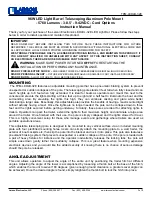
Solar Radiation Sensor Mounts
5
Compliance
CM225:
View EU Declaration of Conformity at:
www.campbellsci.com/cm225-solar-mount
6. Installation
6.1 Siting
The solar radiation sensor is usually installed horizontally, but can also be
installed at any angle including an inverted position. In all cases, it will
measure the flux that is incident on the surface that is parallel to the sensor
surface. Site the sensor to allow easy access for maintenance while ideally
avoiding any obstructions or reflections above the plane of the sensing element.
It is important to mount the sensor such that a shadow or a reflection will not
be cast on it at any time. FIGURE
shows how to calculate the distance
needed from any potential obstruction, using the CMP3 as an example.
FIGURE 6-1. Solar sensor placement
If this is not possible, try to choose a site where any obstruction over the
azimuth range between earliest sunrise and latest sunset has an elevation not
exceeding 5°. Diffuse solar radiation is less influenced by obstructions near the
horizon. For instance, an obstruction with an elevation of 5° over the whole
azimuth range of 360° decreases the downward diffuse solar radiation by only
0.8%. The sensor should be mounted with the cable pointing towards the
nearest magnetic pole. For example, in the northern hemisphere, point the cable
toward the North Pole.

































